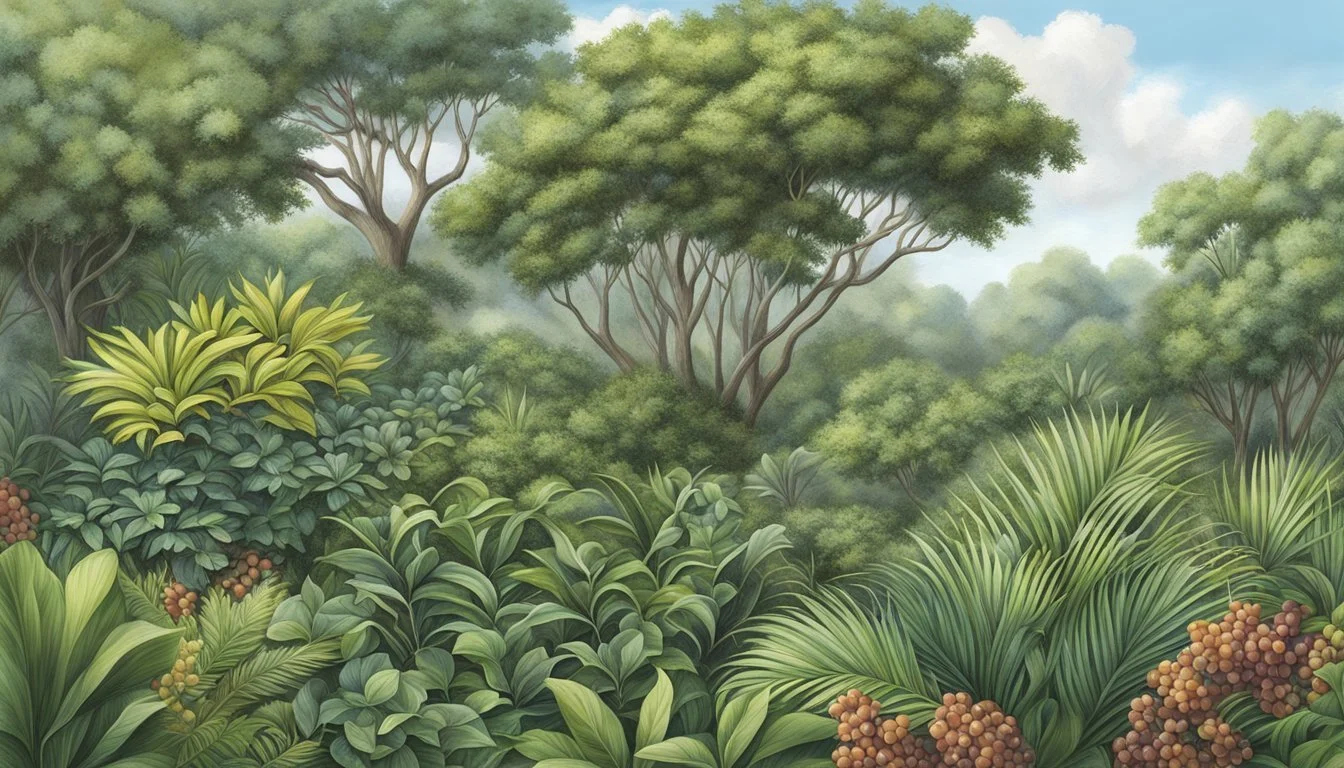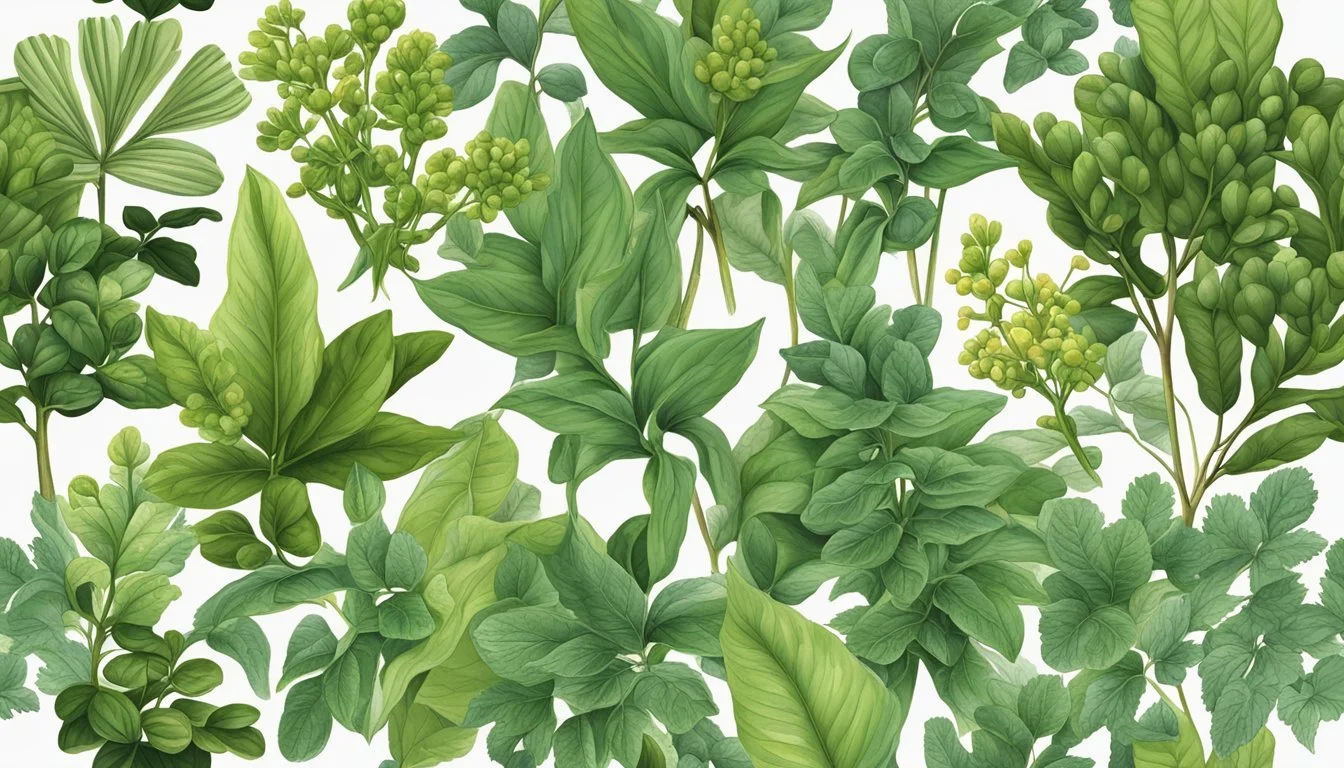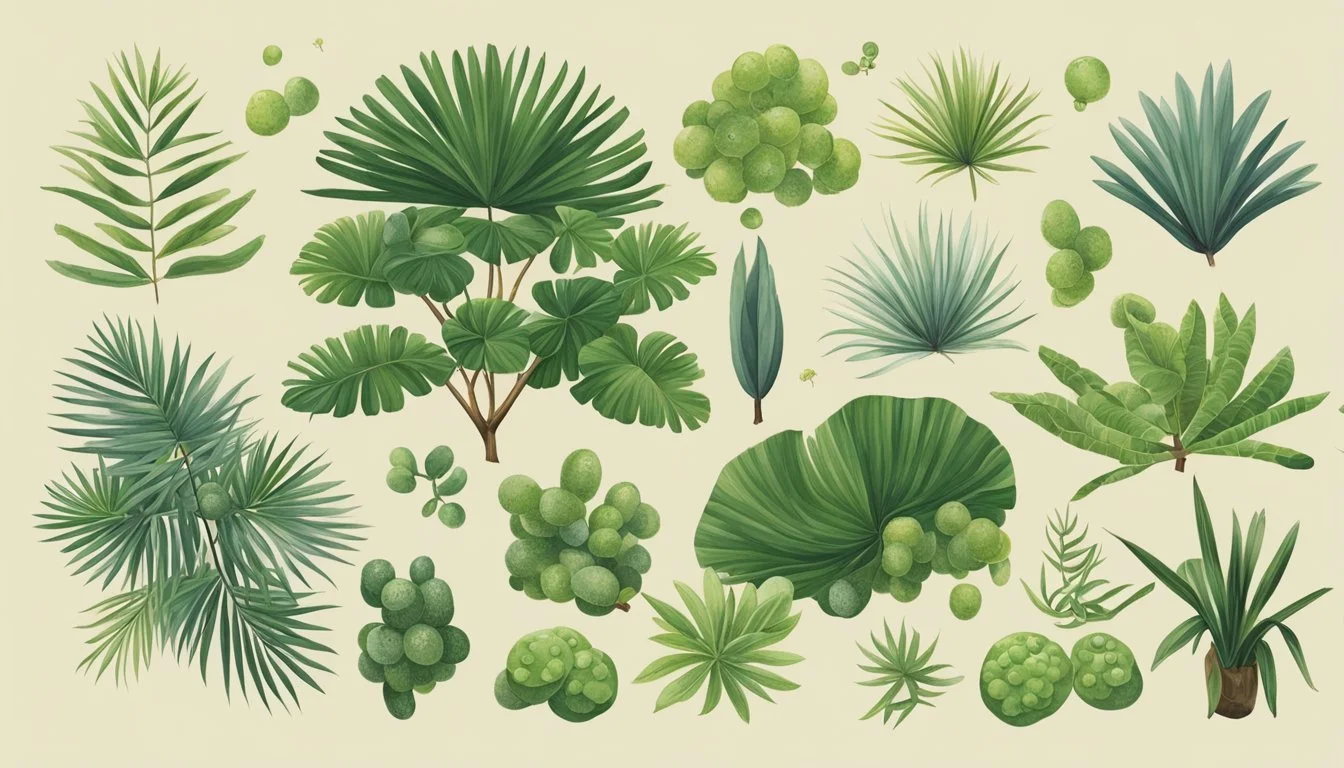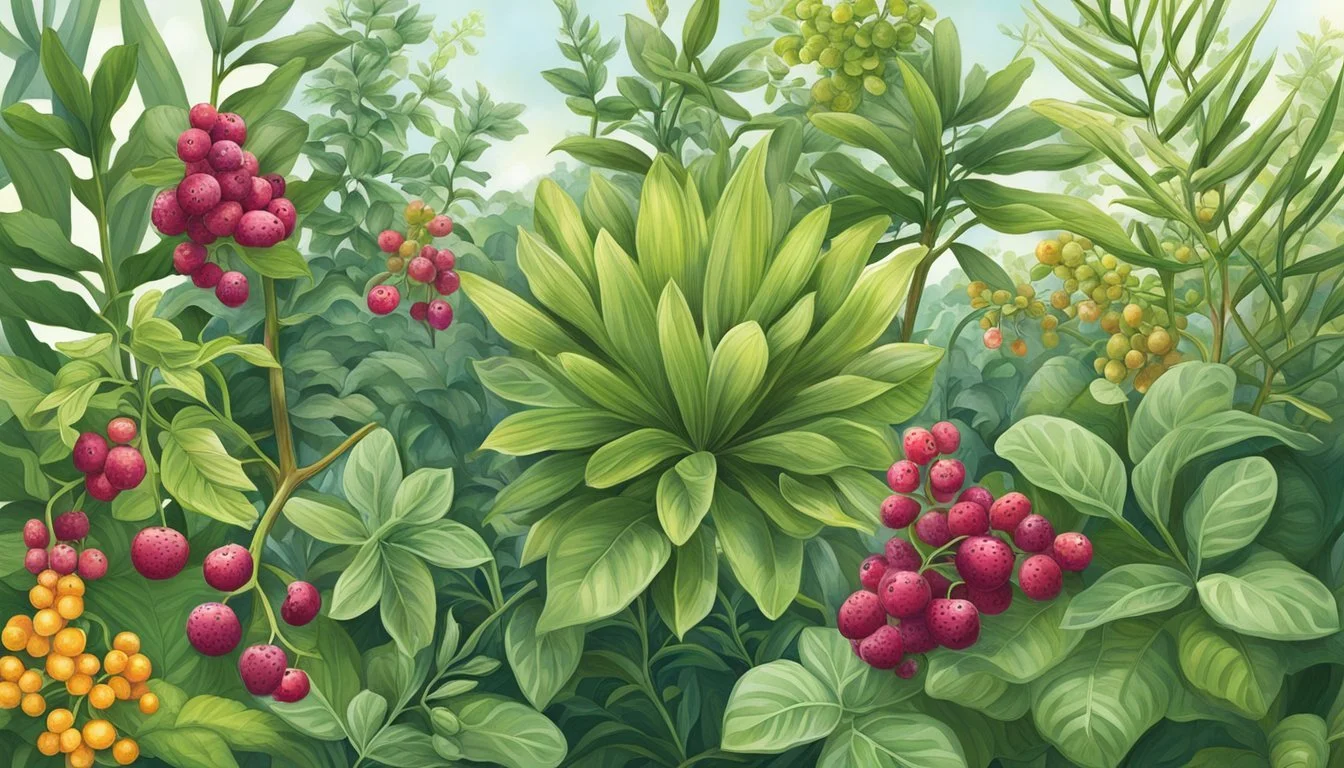Gulf Coast Native Edible Plants
Identification and Benefits
The Gulf Coast region, particularly in Texas, boasts a rich diversity of native edible plants that have sustained its inhabitants for centuries. From sandy dunes to inland marshes, the local flora offers both nutrition and cultural heritage. Prickly Pear Cactus, thriving in these arid landscapes, not only provides edible fruit but also brings a touch of the region's unique ecology to the dining table.
Imagine foraging through the wilds and discovering the dewberry, reminiscent of blackberries, and native pecans, whose delicious nuts were a cornerstone in Native American diets. These native plants, hardy and resilient, showcase the intricate link between the Gulf Coast’s natural environment and its people. Whether foraging in urban areas or exploring coastal habitats, the native edible plants of the Gulf Coast promise a fascinating journey through nature's pantry.
Exploring these native species not only enriches one's diet but also fosters a deeper connection with the very land that defines the Gulf Coast. Understanding the diverse edible plants found in this region enhances our appreciation of its ecosystems and the historical significance they hold.
Importance of Native Edible Plants
Native edible plants offer numerous advantages, including supporting ecosystems, promoting sustainability, and providing culinary and medicinal benefits.
Ecosystem Benefits
Native plants play a vital role in maintaining local ecosystems. They serve as crucial food sources for birds, bees, and other wildlife. For instance, pawpaw and persimmon trees provide sustenance for various insects, which, in turn, support songbird populations.
These plants also help stabilize soil and prevent erosion, especially in coastal areas. By using deep root systems, they enhance soil structure and water retention. This not only reduces flooding risks but also fosters diverse habitats for numerous species.
Sustainability and Conservation
Growing native edible plants promotes sustainability and aids conservation efforts. These plants are adapted to local climates and soil conditions, requiring less water, fertilizers, and pesticides. This reduces the environmental impact associated with agricultural practices.
Furthermore, cultivating native species includes preserving regional biodiversity. As these plants don't compete aggressively with local flora, they help maintain balanced ecosystems. Sustainable practices like this are vital for long-term ecological health and resource availability.
Culinary and Medicinal Uses
Native edible plants offer a rich array of culinary and medicinal uses. Fruits like dewberries and elderberries can be used in various recipes, from desserts to preserves. Their flavors are diverse and unique, providing new culinary experiences.
Medicinal properties abound in many native species as well. For instance, the leaves of native passionfruit have potential health benefits and are known for their use in traditional remedies. Utilizing these plants connects modern practices to historical knowledge, enriching both food and health practices.
Recognizing Edible Plants
When foraging for native plants along the Gulf Coast, it's critical to correctly identify which plants are safe to eat. This involves understanding safety protocols, utilizing specific identification techniques, and adhering to ethical foraging practices.
Safety and Caution
Safety is paramount when foraging for edible plants. Many plants can be toxic if misidentified, and some have poisonous parts even if other parts are edible. For example, elderberries should be consumed with caution, as only the ripe berries are safe to eat, while other parts of the plant are toxic.
Always carry a reputable field guide for local edible plants. Avoid foraging in areas exposed to contaminants, such as roadsides or industrial sites. If unsure about a plant’s safety, it's best not to consume it. When trying a new edible plant, start with a small quantity to check for any adverse reactions.
Identification Tips
Accurate plant identification is essential. Look for distinctive features such as leaf shape, color, texture, and the plant’s overall structure. For instance, chanterelles have a unique funnel shape and a bright orange color, which helps distinguish them from other fungi.
Use multiple identification methods. Cross-reference characteristics with a trusted plant guide or use a plant identification app. Photos can sometimes be misleading, so examining the plant in person is often necessary.
Flowers, fruits, and bark also provide important identification clues. Note that some plants resemble edible ones while being toxic, so always double-check identifying features before consumption.
Foraging Ethics
Ethical foraging ensures the sustainability of plant populations and habitats. Only harvest plants that are abundant and avoid overharvesting any single population. A good practice is to take no more than one-quarter of the plant material to ensure the plant can continue to thrive.
Avoid digging up entire plants unless absolutely necessary. Picking leaves, fruits, or seeds rather than uprooting helps preserve the ecosystem. Be respectful of private property and obtain permission before foraging on someone else’s land. Leave no trace by minimizing any disturbance to the surrounding environment.
By following these guidelines, foragers can enjoy the benefits of Gulf Coast edible plants safely and responsibly.
Popular Gulf Coast Edible Plants
The Gulf Coast's unique climate fosters a variety of native edible plants that include fruit-bearing, herbs and greens, nut-bearing trees, and rare and unique species. These plants offer both sustenance and ecological benefits, making them valuable resources for foragers and gardeners alike.
Fruit-Bearing Plants
Muscadine Grapes thrive in the warm Gulf Coast climate. Known for their robust flavor, these grapes can be consumed fresh or used in jellies and wines.
Yaupon Holly produces small red berries, though it is more popular for its caffeine-rich leaves, which are used to brew a traditional tea.
Wild Mulberries and Elderberries are another treat. Mulberries are sweet and can be eaten straight off the tree, while elderberries are better suited for syrups and jams due to their tartness.
Texas Persimmons and common Persimmons are also found here, producing sweet, edible fruit that is often used in desserts and preserves.
Herbs and Greens
Amaranth is a versatile plant often used for its leaves and seeds. The leaves can be cooked like spinach, while the seeds are nutritious and can be toasted.
Sassafras leaves are popular for making filé powder, a thickening agent used in gumbo. Its roots can be brewed into a flavorful tea, though it's recommended in moderation due to potential health concerns.
Dandelion and Chickweed are common wild greens. Dandelion leaves are packed with vitamins and are best used in salads or as cooked greens. Chickweed can be added to salads or used as a garnish.
Nut-Bearing Trees
Pecan Trees are abundant along the Gulf Coast. Pecans are a staple in Southern cuisine, frequently used in pies, candies, and savory dishes.
Hickory Nuts are another local favorite, known for their rich, buttery flavor. They can be eaten raw, roasted, or used in baking.
Black Walnut Trees are less common but still present. Their nuts are highly prized for their strong, distinctive flavor, though they can be challenging to shell.
Rare and Unique Plants
Prickly Pear Cactus, while more common in arid regions, is found in some Gulf Coast areas. Its pads (nopales) and fruit (tunas) are both edible and widely used in Mexican cuisine.
Mayhaw Trees produce small, tart berries that are central to traditional Southern jellies and preserves.
Passionflower (or Maypop) offers unique fruit with a sweet-tart flavor. The vines are also known for their striking flowers, which provide aesthetic as well as culinary value.
The Gulf Coast is rich in native plant species that offer a variety of flavors and uses, each bringing its own unique benefits to the table.
Landscaping with Edible Plants
Incorporating edible plants into the landscape enhances both the beauty and functionality of outdoor spaces. Gardeners can create lush environments that provide food, attract pollinators, and thrive in varied sun conditions.
Creating a Native Edible Garden
Creating native edible gardens involves selecting plants that are well-suited to the local climate and soil. Using Gulf Coast native species ensures that plants are adapted to the regional conditions, reducing maintenance and increasing success rates.
Incorporate a mix of fruit trees, berry bushes, and herbs that can thrive without the need for excessive watering or chemical treatments. A good example is American cranberry bushes, which require moist, acidic soils but offer vibrant, edible berries. Combining these with native herbs such as bee balm can enhance both yield and aesthetics.
Plants for Full Sun and Shade
When planning the landscape, it's important to account for areas that receive full sun and those that are in shade.
For full sun, consider plants like dewberry, which thrive under direct sunlight and produce berries similar to blackberries. Canadian serviceberry is another excellent choice; it offers edible berries and vivid fall colors.
In shaded areas, plants such as wild ginger and mayapple grow well, providing both ground cover and edible parts. These plants not only adapt to low light conditions but also contribute to the biodiversity and resilience of the garden.
Attracting Pollinators
Attracting pollinators such as butterflies and bees is crucial for the health and productivity of an edible garden. Native plants that produce nectar and pollen, like milkweed and coneflower, support local pollinator populations.
Incorporate flowering herbs like lavender and rosemary to provide continuous blooms. Clover can be used as ground cover, enriching the soil and providing essential resources for pollinators. Plant diversity ensures a range of blooming periods, promoting sustained visits from beneficial insects throughout the growing season.
By thoughtfully integrating these elements, gardeners can create vibrant, productive landscapes that support both their needs and the needs of local wildlife.
Integrating Edible Plants into Daily Diet
Incorporating edible native plants into one's daily diet can enhance both the nutritional value and the variety of meals. There are practical and straightforward ways to include these plants, from cooking simple recipes to reaping numerous health benefits.
Simple Recipes and Uses
Many native edible plants can be easily incorporated into everyday meals. Dandelion greens can be added to salads, bringing a unique, slightly bitter taste that complements other greens. Nettle leaves make a nutritious tea or can be included in soups and stews after proper preparation.
For a more robust dish, elderberries can be turned into jams or syrups, perfect for spreading on toast or adding to desserts. Wild nuts, such as acorns, can be processed into flour and used in baking bread, pancakes, or cookies. Smoothies can get a nutritional boost from adding greens like nettles or herbs like wild mint.
Health Benefits
Eating native edible plants provides numerous health benefits due to their high levels of vitamins, minerals, and antioxidants. Dandelion greens are rich in vitamins A, C, and K and are known for their detoxifying properties. Elderberries are celebrated for their immune-boosting qualities, thanks to their high vitamin C and antioxidant content.
Nettle leaves offer considerable iron and calcium, supporting overall bone health and energy levels. Wild edible greens like these also help diversify the diet, which can contribute to better digestive health and nutrient absorption. Incorporating these plants helps connect with nature’s seasonal offerings while fostering a sustainable approach to eating.
Cultural Significance and History
Native plants along the Gulf Coast have played a significant role through centuries, from the utilization by Native American tribes to historical foraging practices that sustained communities.
Native American Uses
Native American tribes, such as the Choctaw and the Atakapa, relied heavily on the region's native plants. They used Canadian serviceberry (Amelanchier canadensis) and other wild plants not only for food but also for medicinal purposes.
These plants were integral to their diet and healthcare systems, offering a mix of vitamins and nutrients. For instance, cattail (Typha spp.) roots provided essential carbohydrates, while swamp milkweed (Asclepias incarnata) was employed in traditional remedies. This knowledge of wild plants was passed down through generations, forming a deep cultural heritage.
Historical Foraging in the Gulf Coast
Throughout the Gulf Coast, settlers and early Americans foraged for native plants to supplement their diets. Coastal dune areas were often planted with beachgrass (Ammophila breviligulata), providing stabilization and edible shoots. Inland regions featured diverse edible species like wild vegetables and tea substitutes.
Sweetbay magnolia (Magnolia virginiana) leaves were often brewed into teas. Southern wax myrtle (Morella cerifera) was used to flavor food. The tradition of foraging in this region highlights the adaptability and extensive knowledge of early settlers, who effectively utilized local ecosystems.
Conservation and Ethical Foraging
In the Gulf Coast region, foraging demands a balance between utilizing natural resources and ensuring their sustainability. This section focuses on local conservation efforts and responsible practices to maintain the region's diverse ecosystems.
Local Conservation Efforts
The Gulf Coast's ecosystems are rich, consisting of coastal marshes, wetlands, and forests. Conservation groups prioritize preserving native plant species. These efforts include habitat restoration, especially after natural disasters, and combating invasive species.
Local parks and wildlife refuges often serve as hubs for conservation activities. Volunteers collaborate with experts to plant native species and monitor their growth. Organizations such as local chapters of environmental groups play a crucial role. They work towards educating the public about the importance of these native plants.
Federal and state agencies also support local efforts. Grants and funding programs aim to protect critical habitats. Policies restrict overharvesting and impose fines to deter illegal foraging. These collective efforts ensure that the Gulf Coast's native plants can thrive for generations.
Responsible Foraging Practices
Foragers must follow ethical guidelines to protect native plants. Obtaining permission before foraging on private lands is paramount. Respecting property rights prevents conflicts and fosters goodwill between foragers and landowners.
Sustainable harvesting is essential. Only a small portion of any plant population should be collected. This practice minimizes environmental impact and allows for natural regeneration. Precision in identifying species is crucial to avoid mistakenly collecting endangered or harmful plants.
Awareness of local laws and regulations is necessary. Foragers should be informed about protected species and restricted areas. Using resources like guidebooks and apps aids in accurate identification and ethical collection methods.
Engaging in responsible foraging practices not only preserves the environment but also enhances the foraging experience by maintaining the natural beauty and biodiversity of the Gulf Coast.
Challenges and Threats
Restoring and maintaining the diversity of Gulf Coast native edible plants involves addressing several specific challenges. Among these are the pressures from invasive species and the impacts of climate and weather, which can significantly affect their survival and health.
Invasive Species
Invasive species pose a significant threat to Gulf Coast native edible plants. These non-native plants can outcompete native species for resources such as light, nutrients, and water. One example is cogon grass (Imperata cylindrica), which aggressively spreads and dominates large areas, reducing space for beneficial native plants like beachgrass and serviceberry.
Furthermore, invasive species can alter soil composition and disrupt local ecosystems. For instance, the Brazilian pepper tree (Schinus terebinthifolia) alters soil pH and nutrient levels, making it challenging for native plants to thrive.
Effective management strategies include ongoing monitoring and removal of invasive species. However, this requires substantial time and resources, often necessitating community involvement and persistent efforts. Vigilant replanting of native species is crucial to counteract the spread of invasive plants.
Climate and Weather Impacts
Climate change and extreme weather events significantly impact the survival of Gulf Coast native edible plants. Rising temperatures can alter growth cycles and increase stress on plants, making them more susceptible to diseases and pests.
Storms and hurricanes frequent the Gulf Coast, causing physical damage to plant communities. For example, storm surges can lead to saltwater intrusion, which adversely affects freshwater-dependent species. Heavy rains and flooding can erode soils and uproot plants, while prolonged droughts can lead to water scarcity, further stressing native vegetation.
Adaptive strategies are necessary for preserving native plants under changing climate conditions. This includes selecting resilient plant varieties and creating buffer zones with plants that can withstand harsher conditions. Ongoing research and monitoring are essential to understand and mitigate these impacts over time.
Educational Resources and Initiatives
Educational resources and initiatives play a crucial role in promoting the knowledge and conservation of Gulf Coast native edible plants. These include local workshops, guided walks, and online guides that provide valuable information on sustainable harvesting and utilization of these plants.
Local Workshops and Guided Walks
Local workshops and guided walks offer hands-on learning experiences for individuals interested in Gulf Coast native edible plants. Events like the one hosted by Dr. Charles Allen in Picayune, MS, teach participants about foraging and identifying useful plant species. These workshops often involve botanists and conservationists who share their expertise on native flora.
Key locations to look for these activities include:
The Lady Bird Johnson Wildflower Center in Texas
Various events in Houston and surrounding areas
Activities and programs across the Gulf South
These in-person learning opportunities are ideal for gaining practical skills and meeting like-minded individuals.
Online Guides and Literature
For those who prefer self-paced learning, several online resources offer comprehensive guides and literature on Gulf Coast native edible plants. Websites like GRuB provide detailed curriculum materials for K-12 education, emphasizing the importance of native and naturalized plants.
Useful online resources include:
Wildflower Center's online plant database
Digital guides and e-books focusing on Texas native plants
Educational websites offering downloadable resources and videos
These online materials are perfect for deepening one's understanding from the comfort of home. They ensure that knowledge about native plants is accessible to a broader audience, contributing to the conservation and sustainable use of these valuable resources.











